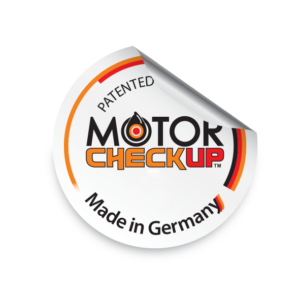

MOTORcheckUP
EVALUATION
After applying a drop of oil to the test paper, you will see a picture
with up to 4 circles based on the chromatographic effect.
MOTORcheckUP
EVALUATION
After applying a drop of oil to the test paper, you will see a picture
with up to 4 circles based on the chromatographic effect.
As motor oil is sluggish, the so-called development process will take some time. Depending on the age of the oil, the final result will take between 1.5 and 8 hours. It is best to leave the test result overnight and then compare it with the reference pictures.
To make it easier, each test set contains the pictured template for evaluation of the test results.
Always proceed step by step. Compare as you go, from the inner circle to the outer circle.
The Inner Circle
Shows whether the oil has been contaminated by small particles – for example, exhaust particles, grime, dust, abrasions or other substances.

The Second Circle
Shows whether the oil is still OK. Compare the coloration of the oil.
Benzin condition

The Jagged Circle
Water in the oil forms defined peaks in the outer areas, whereas coolant forms a yellow ring around the jagged circle.

The Fuel Circle
Hold the test paper facing towards the light. The larger the transparent ring around the outside, the more fuel there is in the oil.

The Inner Circle
shows whether the oil has been contaminated by small particles – for example, exhaust particles, grime, dust, abrasions or other substances.

The Second Circle
Shows whether the oil is still OK. Compare the coloration of the oil.

The Jagged Circle
Water in the oil forms defined peaks in the outer areas, whereas coolant forms a yellow ring around the jagged circle.

The Fuel Circle
Hold the test paper facing towards the light. The larger the transparent ring around the outside, the more fuel there is in the oil.

Training of the evaluation!
As motor oil is sluggish, the so-called development process will take some time. Depending on the age of the oil, the final result will take between 1.5 and 8 hours. It is best to leave the test result overnight and then compare it with the reference pictures.
To make it easier, each test set contains the pictured template for evaluation of the test results.
Always proceed step by step. Compare as you go, from the inner circle to the outer circle.
The Inner Circle
Shows whether the oil has been contaminated by small particles – for example, exhaust particles, grime, dust, abrasions or other substances.

The Second Circle
Shows whether the oil is still OK. Compare the coloration of the oil.
Benzin condition

The Jagged Circle
Water in the oil forms defined peaks in the outer areas, whereas coolant forms a yellow ring around the jagged circle.

The Fuel Circle
Hold the test paper facing towards the light. The larger the transparent ring around the outside, the more fuel there is in the oil.

The Inner Circle
shows whether the oil has been contaminated by small particles – for example, exhaust particles, grime, dust, abrasions or other substances.

The Second Circle
Shows whether the oil is still OK. Compare the coloration of the oil.

The Jagged Circle
Water in the oil forms defined peaks in the outer areas, whereas coolant forms a yellow ring around the jagged circle.

The Fuel Circle
Hold the test paper facing towards the light. The larger the transparent ring around the outside, the more fuel there is in the oil.














